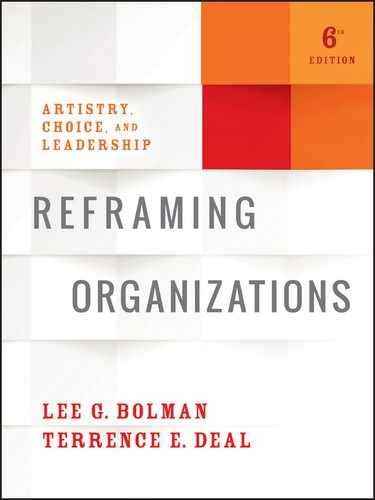Appendix
The Best of Organizational Studies
One goal for our book is to cover the most important and influential works in the field and cite or summarize them where appropriate. There is no perfect way to determine the best or most important books and articles, but we can assess which ones scholars pay the most attention to.
Scholars' Hits
Our list of scholars' “greatest hits” relies on citation analysis—how often a work is cited in the scholarly literature. This method is often used to measure scholarly impact. We began by conducting a citation analysis of the two journals that Trieschmann, Dennis, and Northcraft (2000) cited as the most visible and influential in the field of management: Academy of Management Journal (AMJ, for the years 1996 to 2009) and the Administrative Science Quarterly (ASQ, for the years 1993 to 2009). We combined the analyses from those two journals to get a list of the “top 20” articles and books based on citation frequency. (In identifying our top 20, we excluded purely methodological works that dealt with statistical analysis or research methods.)
We then conducted an additional analysis using Google Scholar (GS) as of November 2016. GS provides a broadly inclusive analysis of citation data for scholarly work. This gave us three separate rankings: AMJ, ASQ, and GS. The first two are specific to the field of organization studies. The GS data provide a broader indication of influence both within and beyond the management field. For the items in our top 20, the correlations among AMJ, ASQ, and GS are positive but low (ranging between .09 for AMJ/ASQ to .27 for ASQ/GS). We believe this reflects reality. Scholars who publish in different journals or come from different disciplines have different tastes and prefer different sources. It also suggests that our results are somewhat arbitrary, because a different set of journals might have produced different results. The results for the top 20 are shown in Exhibit A.1.
Exhibit A.1. Top 20 “Scholars' Hits” from Citation Analysis.
| AMJ Rank | ASQ Rank | GS Rank | Overall Rank | Author | Year | Title |
| 1 | 1 | 4 | 1 | DiMaggio, P. J., and Powell, W. W. | 1983 | “The Iron Cage Revisited: Institutional Isomorphism and Collective Rationality in Organizational Fields” |
| 2 | 2 | 9 | 2 | Pfeffer, J., and Salancik, G. | 1978 | The External Control of Organizations: A Resource Dependence Perspective |
| 3 | 2 | 8 | 3 | Cyert, R. M., and March, J. G. | 1963 | A Behavioral Theory of the Firm |
| 9 | 3 | 10 | 4 | Meyer, J., and Rowan, B. | 1977 | “Institutionalized Organizations: Formal Structure as Myth and Ceremony” |
| 7 | 4 | 12 | 5 | Thompson, J. D. | 1967 | Organizations in Action: Social Science Bases of Administrative Theory |
| 11 | 6 | 7 | 6 | Granovetter, M. S. | 1985 | Economic Action and Social Structure: The Problem of Social Embeddedness |
| 4 | 20 | 1 | 7 | Jensen, M. C., and Meckling, W. H. | 1976 | “Theory of the Firm: Managerial Behavior, Agency Costs, and Ownership Structure” |
| 10 | 10 | 12 | 8 | March, J. G., and Simon, H. A. | 1958 | Organizations |
| 9 | 17 | 8 | 9 | Nelson, R. R., and Winter, S. G. | 1982 | An Evolutionary Theory of Economic Change |
| 11 | 8 | 18 | 10 | Burt, R. S. | 1992 | Structural Holes: The Social Structure of Competition |
| 16 | 15 | 20 | 12 | Williamson, O. E. | 1975 | Markets and Hierarchies |
| 13 | 10 | 19 | 13 | Hannan, M. T., and Freeman, J. | 1984 | “Structural Inertia and Organizational Change” |
| 16 | 5 | 33 | 15 | Hannan, M. T., and Freeman, J. | 1989 | Organizational Ecology |
| 17 | 11 | 24 | 14 | Levitt, B., and March, J. G. | 1988 | “Organizational Learning” |
| 21 | 24 | 4 | 11 | Williamson, O. E. | 1985 | The Economic Institutions of Capitalism |
| 21 | 16 | 25 | 17 | Uzzi, B. | 1992 | “Social Structure and Competition in Interfirm Networks: The Paradox of Embeddedness” |
| 21 | 12 | 35 | 18 | Levinthal, D. A., and March, J.G. | 1993 | “The Myopia of Learning” |
| 6 | 30 | 23 | 16 | Scott, W. R. | 1985 | Institutions and Organizations |
| 21 | 21 | 27 | 19 | Stinchcombe, A. L. | 1965 | “Social Structure and Organizations” |
| 4 | 40 | 28 | 20 | Hambrick, D. C., and Mason, P. A. | 1984 | “Upper Echelons: The Organization as a Reflection of Its Top Managers” |
The results are not definitive, but they identify some of the works that have had the greatest influence on scholars. To reduce our list to a single rank order, we averaged the rankings across the three separate databases. For example, our highest ranking went to an article by DiMaggio and Powell (1983) that ranked first in AMJ and ASQ and fourth in GS.
Though the citation analysis is based on articles published in the 1990s and 2000s, many of the works that appear at the high end of the list were published much earlier, in the 1960s, 1970s, and 1980s. The oldest item in the top 20 was published in 1958, the newest in 1993. The results suggest that there is typically a lag of a decade or more before a new work can become a widely cited “classic.”
